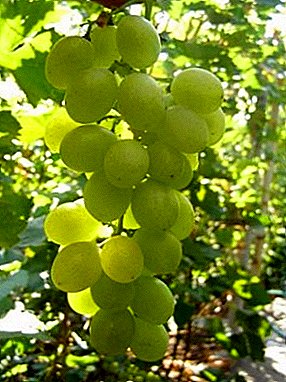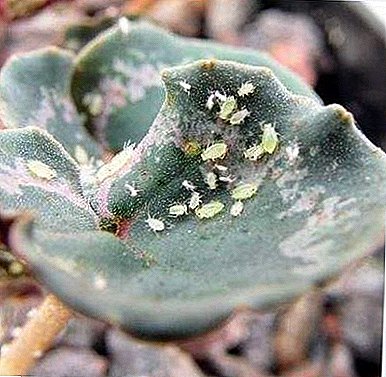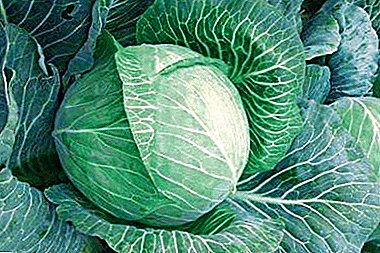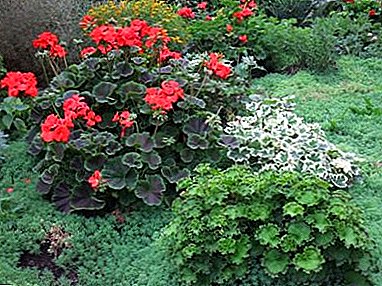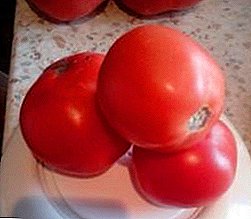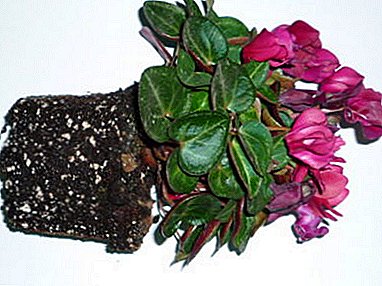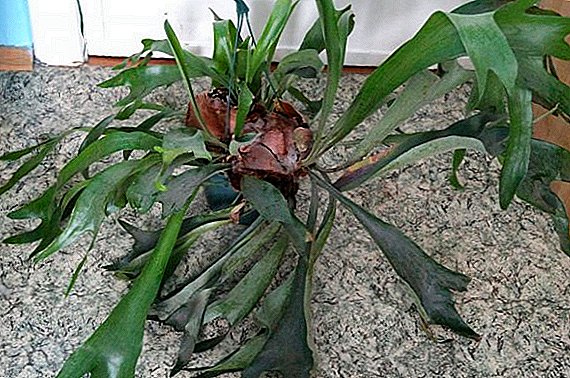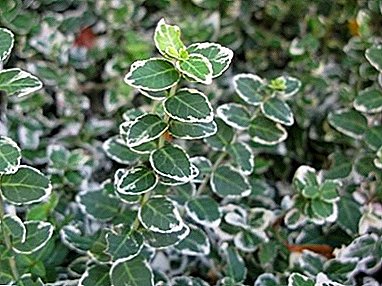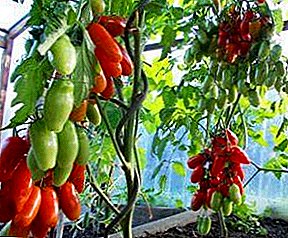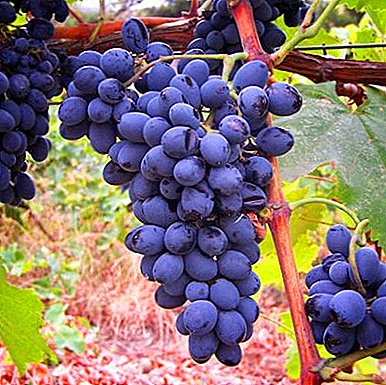
About variety Saperavi I can safely say that this is the oldest known grape variety today.
Very much appreciated in their homeland, in Georgia, as the best variety for wine production.
It has a very attractive appearance and delicious taste.
What kind of grape is it?
Saperavi - A great wine grape variety. Best for making red dessert and fortified wines, but with sufficient maturity can be consumed fresh.
The taste and quality of the wine produced directly depends on the place of growing of grapes.
Saperavi - This is typically a southern variety, not intended for middle latitudes. Prefers a well-moistened, but not swampy soil, with a minimum salt and lime content. It grows well only in warm climates.
Among the wine varieties, Rkatsiteli, Merlot and Tempranillo are also widely known.
Variety description
Saperavi is a very tall variety. The leaves are large, rounded, light green, pubescent.
The ripening of the vine is good almost to its full length. Flowers bisexual, not requiring special pollination.
Cardinal, Aladdin and Lily of the Valley are distinguished by double-faced flowers.
The cluster is small, friable, conical, but somewhat shapeless, weight up to 90-110 g.
The berries are medium-large, dark blue, rounded, with a slight waxy bloom, weighing about 4-6 grams, prone to pea. There are 2-3 large seeds in each berry.
The flesh is very juicy, melting, with high sugar content and thick dark pink juice. The skin is thin, but rather dense.
High sugar content is also distinguished by Delight White, King Ruby and Kishmish 342.
A photo
Photos of grapes "Saperavi" below:





Breeding history
The time of its appearance is not known for certain.
This variety has several names: Didi Saperavi, Dyer, Saperavi Kakhet. It is zoned in Georgia, Moldova, Ukraine, Azerbaijan and the southern regions of Russia. Recently began to grow in Uzbekistan, some European countries and America.
With his participation, a huge number of new unique grape varieties, for example, Saperavi NorthDesigned for growing in temperate and even cold climates.
Specifications
 Saperavi belongs to the late varieties. From the appearance of buds to ripening berries passes about 140-160 days. Differs in high productivity and average winter hardiness. Maintains frosts not lower than-20С.
Saperavi belongs to the late varieties. From the appearance of buds to ripening berries passes about 140-160 days. Differs in high productivity and average winter hardiness. Maintains frosts not lower than-20С.
Bull Eye, Manicure Finger and Regent also have late ripening periods.
The south of the growing region, the better the harvest. It grows well on light, unsalted soils, with good light and regular watering. Saperavi berries can remain on the vine for a long time without losing its taste.
Wine from this variety tends to improve with age. The young wine has a sharp and not very pleasant taste, but after 4-10 years of aging it changes dramatically.
In the care of Saperavi undemanding. When pruning, 40-50 eyes should be left per bush or 9-10 eyes per shoot. The greatest yield can be obtained only from an adult, 10-15-year-old plant.
Among the unpretentious varieties can be distinguished Aleshenkin dar, Delight Muscat and Giovanni.
The variety Saperavi is unstable to some fungal diseases, and is often attacked by pests.
Diseases and pests
 Most often Saperavi suffers from mildew, oidium and gray rot. It is not susceptible to attack by a sheet maker Most dangerous pest for Saperavi - root and leaf phylloxera.
Most often Saperavi suffers from mildew, oidium and gray rot. It is not susceptible to attack by a sheet maker Most dangerous pest for Saperavi - root and leaf phylloxera.
The variety is quite simple to grow, subject to preventive protective measures.
Mildew is a dangerous fungus.appearing on the leaves and shoots in the form of light yellow spots. Dealing with an already emerging disease is not easy.
It is better to prevent its occurrence by thoroughly weeding and spraying with Bordeaux mixture before and after flowering, and during the ripening of the berries. With proper care, this unpleasant disease can be avoided.
Oidium infects the leaves, flowers and grapes, and is expressed in the appearance of dark gray spots with an unpleasant putrid odor. In order not to subject the plant to infection, it is necessary to ensure good ventilation of the bush and regularly treat it with a solution of colloidal sulfur.
Spraying is carried out at least 4 times a year.
If you do not comply with prevention, you can lose not only the harvest, but also the whole vineyard.
Gray rot often appears in hot weather with high humidity, and causes enormous damage to the crop. Both leaves and berries are affected.
The first signs of the disease - the appearance of white dust. Salvation from this scourge will be regular treatment of the bush with a solution of potassium iodide or baking soda. You should not often resort to nitrogen supplements, you can not allow thickening of the bush and waterlogging.
Do not neglect the prevention of such common diseases as anthracnose, bacteriosis, chlorosis and rubella.
 For Saperavi, the most dangerous pest is phylloxera. Phylloxera root affects the roots of plants. Effective means of dealing with it yet.
For Saperavi, the most dangerous pest is phylloxera. Phylloxera root affects the roots of plants. Effective means of dealing with it yet.
The only option to prevent the death of the entire vineyard is the destruction of damaged bushes and quarantine for landing for 3-4 years.
Leaf phylloxera does no less harm, but you can fight it. The first signs of phylloxera appear: the formation of characteristic swelling on the underside of the leaf and the presence of a small number of larvae.
In this case, timely removal of damaged leaves and treatment with fungicides will help.
Saperavi North
Northern Saperavi - Technical Wine Grade, which appeared as a result of crossing grape varieties Saperavi and North. The resulting variety has unique properties.
This relatively young variety was received in 1947 Russian breeders Ya. I. Potapenko, E. And Zakharova and I. P. Potapenko.
The main difference from the parent variety is increased frost resistance and disease resistance. Northern Saperavi can withstand a drop in t to -30C and zoned in some regions of Ukraine and Russia.
It can be grown even in areas with a harsh climate, subject to careful shelter for the winter.
Grades Richelieu, Rusven and New Century have good frost resistance.
The shrub is medium thick, the cluster is small, friable, with small berries of dense blue color. The harvest is high and stable, fully ripened at the end of September.
The variety does not tolerate drought and is demanding on the composition of the soil.
With insufficient watering prone to shedding berries.
 Saperavi North is almost not affected by mildew and gray mold, but it is unstable to oidium.
Saperavi North is almost not affected by mildew and gray mold, but it is unstable to oidium.
Attacked phylloxera and most grape pests are not affected.
If the variety Saperavi can be grown only in a very warm climate and subject to certain conditions, then the Northern Saperavi is perfect for a summer cottage in central Russia.
Saperavi and Saperavi North - wonderful varieties, from which they get a huge number of species juice and wine.


